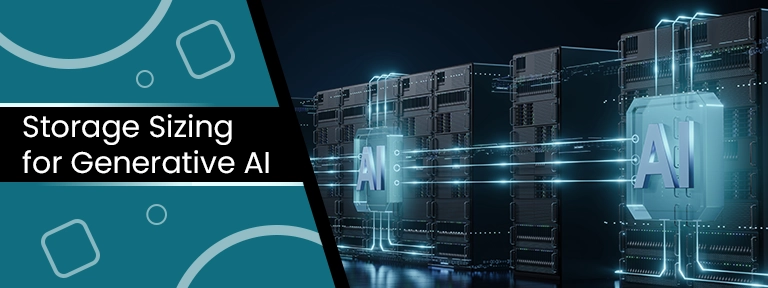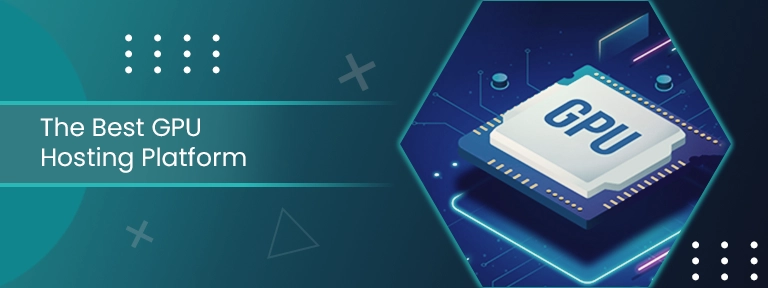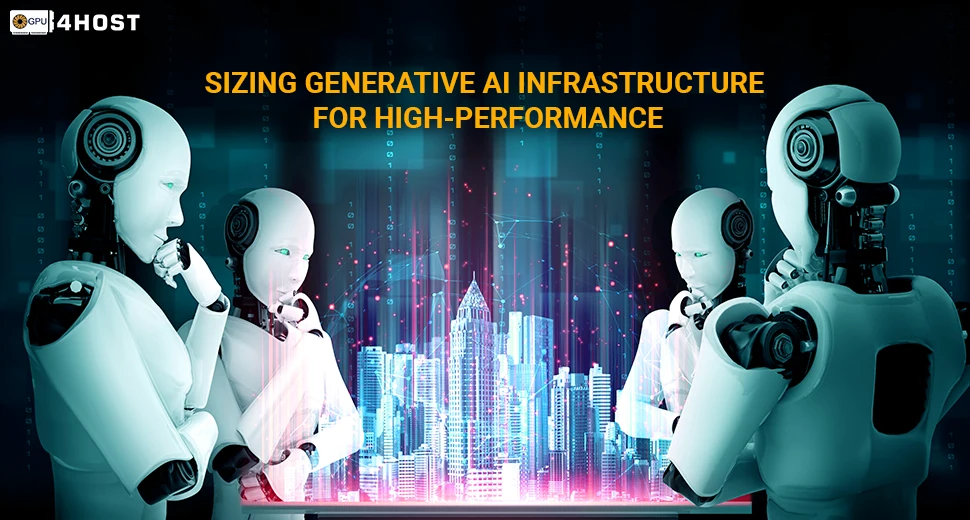Sizing Generative AI Infrastructure for High-Performance
Designing & enhancing your Generative AI infrastructure is very important to achieving high performance, budget-friendliness, and scalability in AI-based tasks. It doesn’t matter if you are training complex language models, developing an AI image generator, or deploying inference pipelines; knowing about how to size compute, GPU, storage, and network is a must.
This guide offers a practical, hands-on tactic to sizing your Generative AI infrastructure utilizing advanced hardware and cloud or on-premises solutions such as GPU server, GPU hosting, and GPU clusters. Let’s simply break down all the necessary components.
1. Knowing About Generative AI Tasks
Generative AI consists of tasks like:
- Training transformer-driven models (for example, GPT, Stable Diffusion)
- Image, video, & audio generation
- Text-to-image models (AI image generator)
- Refining pre-trained models
All the above-mentioned tasks are mainly resource-intensive, generally in terms of memory bandwidth, GPU compute, and I/O throughput. The needs for your Generative AI infrastructure can change depending on whether you are training large models or running inference.
2. Compute Sizing for Generative AI Infrastructure
The compute layer is fundamental. In the case of generative AI, CPUs first coordinate data pipelines and handle the tasks, while GPUs do the heavy lifting.
Suggestions:
- CPU: For training, look for high-core-count processors (for example, AMD EPYC or Intel Xeon) with powerful single-thread and multi-thread performance.
- Memory (RAM): A Minimum of 128GB is suggested for mid-scale tasks; complex models may need 256 GB+.
Tip: Match CPU performance with your GPU server to prevent any type of bottlenecks in your Generative AI infrastructure.
3. GPU Sizing: The Core of Generative AI
The GPU is the most essential factor in your Generative AI infrastructure. Model training and inference both completely depend on TFLOPS, GPU memory size, and parallel processing proficiencies.
Well-Known GPU Options:
- NVIDIA V100: A popularly utilized AI GPU, best for both model training and inference.
- A100 or H100: For cutting-edge performance (best for state-of-the-art GPU clusters).
- RTX 3090/4090: Budget-friendly option for new businesses and developers.
How to Select:
- For AI image generator tools such as Stable Diffusion, a minimum of 24 GB of VRAM is needed.
- For complex model training, 4–8 NVIDIA V100 or equivalent in a GPU cluster.
- For inference, very less GPUs with powerful memory bandwidth can serve.
Practical Setup: A GPU dedicated server along with 4×V100s and 256GB RAM can easily support complete model training cycles productively.
Utilize GPU hosting platforms that support customization and scaling as per your model size and framework (for instance, PyTorch, TensorFlow).
4. Storage Sizing for Generative AI

Storage is generally underestimated, but necessary for your Generative AI infrastructure, specifically at the time of training, where both checkpoints and datasets can be huge.
Storage Types:
- NVMe SSDs: For model training and inference tasks; give priority to IOPS and read/write speeds.
- HDDs or object storage: For archival of huge datasets, logs, and checkpoints.
Suggestions:
- For training: 2–4 TB NVMe per GPU server
- For inference: 1 TB NVMe is completely sufficient.
- Utilize parallel file systems (such as Lustre, BeeGFS) for advanced GPU clusters.
Bonus Tip: Keep training all available datasets on local NVMe at the time of active use to decrease latency.
5. Network Sizing in Generative AI Infrastructure
Your network infrastructure can easily influence model training time remarkably, especially at the time of utilizing distributed systems or GPU clusters.
Key Considerations:
- Intra-node bandwidth: Utilize 10 Gbps or higher for more efficient data transfer between multiple GPU servers.
- InfiniBand support: For high-performance computing (HPC) clusters, InfiniBand is often utilized for <1ms latency and up to 200 Gbps bandwidth.
- Cloud vs On-prem: Cloud GPU hosting usually provides scalable bandwidth options; on-premises configurations should consider dedicated switches and fiber connections.
Best Practice: Guarantee high-throughput, low-latency network links between compute nodes in your Generative AI infrastructure.
6. Scalability with GPU Clusters
As your tasks’ demand increases, individual GPU servers may not do everything. Simply, enter GPU clusters—groups of a GPU dedicated server linked with each other to act as a solo compute fabric.
Advantages:
- Parallel training across different nodes
- Fault tolerance and the mechanism of failover
- Elastic flexibility in cloud-based GPU hosting
Setup Instance:
- 8×GPU cluster utilizing NVIDIA V100 cards
- Shared 10 Gbps fabric
- Distributed file system (such as NFS or BeeGFS)
This whole setup helps complex model training (for example, 13 B+ parameters) with data parallelism and model sharding.
7. Selecting the Best GPU Hosting Platform

At the time of developing or scaling your Generative AI infrastructure, make sure to always go with on-premises hardware or cloud-based GPU hosting like GPU4HOST.
Cloud GPU Hosting:
- Quick provisioning
- No hardware maintenance costs
- Best for short-term or burst tasks
On-premises GPU Servers:
- Lower enduring cost
- Full control over setup and security
- Needed for businesses with strict data compliance requirements
- Hybrid setups can easily balance cost, flexibility, and performance.
Opt for GPU hosting service providers like GPU4HOST, which offers high-speed SSDs, 10 Gbps+ networking, and a variety of options for multi-GPU servers.
8. Practical Sizing Scenarios
| Real-World Use Case | Suggested Setup |
| Text-to-image Generation (Stable Diffusion) | 1×NVIDIA V100 or 3090, 64GB RAM, 1TB NVMe |
| Large Model Training (LLM, >1B parameters) | 4–8×V100, 256GB RAM, 2TB NVMe, 10Gbps network |
| Inference and Deployment | 1×A100 or V100, 64GB RAM, 500GB SSD |
Customize your Generative AI infrastructure to your particular tasks for maximum ROI.
Conclusion
Sizing compute, GPU, storage, and network for Generative AI infrastructure is a very challenging but necessary step toward productive AI model deployment. Ranging from selecting the best GPU server to scaling with GPU clusters, every single component plays a remarkable role in both cost and performance.
If you are developing an AI image generator, running transformer models, or refining LLMs, make sure that your Generative AI infrastructure is enhanced for high speed, flexibility, and scalability.
Utilize advanced GPU hosting solutions or cutting-edge GPU dedicated servers to prevent underpowered setups. Platforms like GPU4HOST, providing NVIDIA V100, high RAM, fast SSDs, and 10 Gbps network, are best for today’s demanding AI-based tasks.


